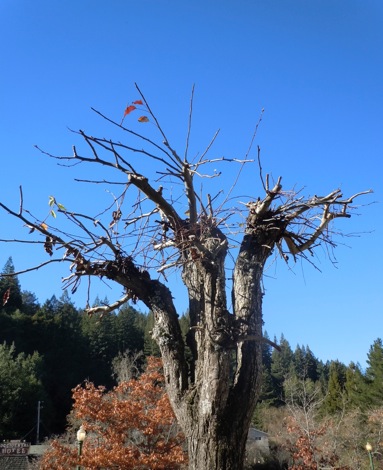Winter Pruning
The traditional season for pruning is while the buds are dormant in late winter or very early spring, before flowers or leaves open. Such pruning stimulates new vegetative shoots which are not initially fruitful. Cutting back a dormant branch will cause two or more side shoots to arise below the cut--due to lost apical dominance (the bud at the tip of a shoot). Thus, winter pruning is used to "force" branches by cutting back a limb or trunk to a point just above where you want a new shoot. Winter pruning is especially helpful when a tree is young to stimulate new branches and fill the air space around the trunk with branches.
When there are many long, vertical shoots; erroneously called "suckers" or "water sprouts," winter pruning will only make the problem worse. Thinning each vertical limb, even if cut to its base, usually causes two or more shoots to arise with the spring sap flow--multiplying the problem.

Tree Bondage - Yikes! This tree has been butchered as a casualty of severe winter pruning. This is from my village’s little downtown. It’s in front of a grocery store. This ornamental Bradford pear was planted 20 years prior in front of the store. Consequently the tree obscured the sign. Alas, the poor tree has been deformed by exclusively winter pruning.
The situation of this bastardized tree may be remedied with summer pruning. This tree should be pruned only in the summer to slowly, over four or more years, reduce the size of the canopy. (Although this poor tree has been maimed so much it may never be restored.)
|

